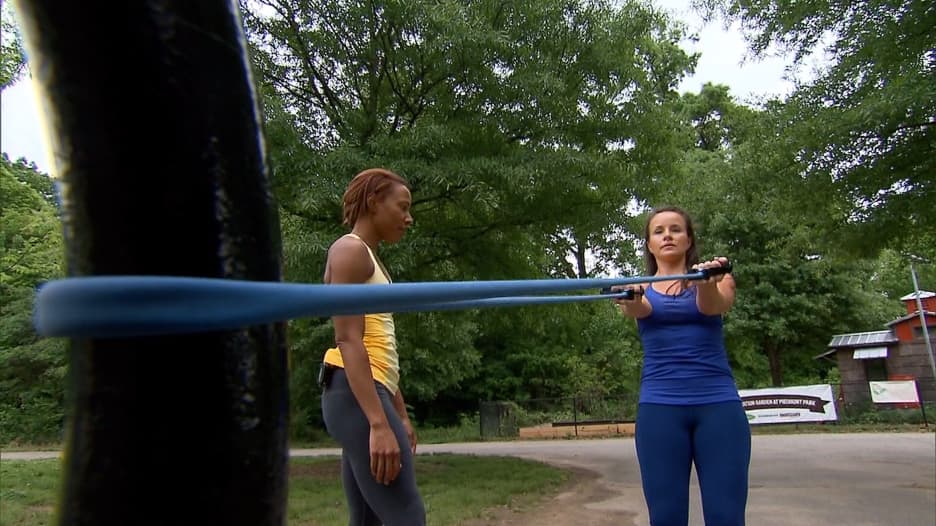دبي، الإمارات العربية المتحدة (CNN)-- خلال نهائيات مسابقة "حصان الحلق" (أو حصان المقابض) للرجال في دورة الألعاب الأولمبية، السبت، تخلّى لاعب الجمباز ستيفن نيدوروسيك عن نظارته قبل أدائه.
ورغم ذلك، نجح بالحصول على ميداليته البرونزية الثانية في أولمبياد باريس.
نيدوروسيك ليس الرياضي الأولمبي الوحيد الذي يعاني من ضعف البصر ويتفوّق في رياضته. فقد تخلى السبّاح الأيرلندي، دانييل ويفين، عن نظارته قبل الفوز بالميدالية الذهبية في سباق 800 متر سباحة حرة، ضمن منافسات الألعاب الأولمبية، الثلاثاء.
وقال نيدوروسيك لـCNN: "الأمر الذي يُميّز حصان الحلق أنك تستخدم يديك طوال الوقت.. أنت تشعر بكيفية دوران مركز كتلتك.. لا أحتاج إلى رؤية ما أفعله لأنّني أتّبع حواسي".
وفي مدونة صوتية نُشرت الجمعة، وجهت لاعبة كرة القدم في المنتخب الوطني الأمريكي، بيكي ساوربرون، تحية إلى نيدوروسيك، حيث شاركت تجاربها في اللعب من دون عدسات تصحيحية، قائلة: "أستطيع تمييز هوية كلّ شخص من خلال مشيته".
يقدم دماغك يدّ المساعدة
يعاني نيدوروسيك من حالتين صحيتين، وهما الحول البصري والثلامة. ويُقصد بالحالة الثانية فقدان الأنسجة في جزء من العين.
وبعيدًا من مشكلة وضوح الرؤية، يمكن أن تؤثر مثل هذه الحالات على إدراك العمق، وهو عنصر أساسي في ألعاب الجمباز والرياضات الأولمبية الأخرى، وفقًا للدكتورة روبا وونغ، طبيبة عيون الأطفال في عيادة هونولولو للعيون والمتحدثة باسم الأكاديمية الأمريكية لطب العيون.
ومع ذلك، يمكن أن تتكيّف أدمغة الرياضيين مع مشاكلهم البصرية من خلال ما يُعرف بـ"الليونة العصبية".
وأوضح الدكتور جوردون وادينغتون، أستاذ طب الرياضة والتمارين الرياضية في معهد جامعة "كانبيرا" للأبحاث والتمارين الرياضية والمعهد الأسترالي للرياضة: "المرونة العصبية هي عندما يتمكن الدماغ من تغيير المكان الذي يحصل منه على المعلومات".
وتسمح مجموعة من "القنوات أو أنظمة المعلومات" للشخص بالشعور بموقعه، سواء من خلال حوّاس اللمس أو الشمّ أو السمع أو الرؤية.
ونظرًا لكون كل شخص فريد من نوعه، فإننا نعتمد على تركيبات مختلفة ونقاط قوة متفاوتة لهذه الأنظمة من أجل تكوين صورة كاملة عن بيئتنا وموقعنا داخلها.
ما هو "استقبال الحسّ العميق"؟
يُعرف أيضًا بـ"الحاسة السادسة".
ويُساعدنا بدوره على الشعور بأجزاء الجسم وتحديد موقعها، وغالبًا ما يتم الخلط بينه وبين التوازن، وفقًا للدكتور فابريس سارلينيا، الباحث في علم نفس الحركة وعلم الأعصاب بالمركز الوطني الفرنسي للبحث العلمي وجامعة "إيكس مرسيليا".
وقال: "لقد نشأنا على فكرة أن لدينا خمس حواس فقط، وأن الرؤية هي الحاسة المهيمنة.. هذا ليس صحيحًا".
وأضاف: "حتى عندما لا تستطيع رؤية قدمك، فأنت تعرف مكانها بالضبط".
نحن نستخدم الحس العميق في حياتنا اليومية عند شرب رشفة من الماء، أو المشي في الشارع، أو حتى عند القيام بحركات بسيطة مثل إغلاق عينيك لتلمس أنفك بأطراف أصابعك.
وينطبق الأمر ذاته على الرياضيين الأولمبيين، سواء عند تغيير السبّاح اتجاهه في نهاية الجولة أو قفز لاعب الجمباز في الهواء لالتقاط العارضة.
وأظهر الرياضيون الأولمبيون الذين يعانون من ضعف البصر أنك لست بحاجة إلى رؤية مثالية لإنجاز المهمة.
وأوضحت وونغ أن هؤلاء الرياضيين يُمثّلون قدوة للأطفال الذين يعانون من حالات مشابهة وهم في بداية مسيرتهم الرياضية.
ومع تقدم أساليب علاج ضعف البصر، مثل العلاج الجيني، قد تصبح أدوات جديدة متاحة لمساعدة المرضى على المشاركة بشكل أكبر في الرياضة.
وأضافت وونغ: "سنرى العالم ينفتح أكثر أمام الأطفال المعوّقين بصرياً حتى ينجحوا في الوصول إلى مستويات عالية، مثل التي وصل إليها الرياضيون الأولمبيون الحاليون".









